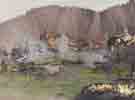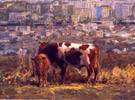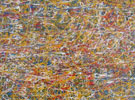
展览时间:2010-10-24 ~ 2010-11-21
展览地点:杰·艺术画廊
参展艺术家:夏航
开幕时间:2010-10-24 15:00
展览介绍:
在雕塑界,夏航是第一个以“玩的雕塑”观念进行创作的艺术家。“玩的雕塑”这一观念,是通过作品的拆装与重组完成体现的。精致而闪闪发光的不锈钢作品,在一次次的拆解、连接、组合中,形象在不断生成演变着,构成一个魔术般的世界。
很显然,夏航的创作观念来源于一种反现代主义的叙事方法,拒绝“崇高”、反对宏大叙事,希望赋予雕塑一种“玩”的品质,以此来消除主客体之间的二元对立,让作品与观众进行互动。同时,那些可以进行拆装与重组的部件,不仅颠覆了既定的雕塑观念,而且也为其形式的拓展带来了无限可能性。
应上海杰•艺术画廊之邀请,将于2010年10月24日举办个展,集中呈现艺术家新一阶段的创作。展览主题名称为“玩趣”,即“玩去了”和“玩的趣味”。他在“玩的雕塑”中又找到了一种新的富有趣味的玩法。
本次展览,值得注意的是,夏航做了一个动画,它是一个关于“阿鲁”和“方块”的玩趣故事。阿鲁在夏航作品中,很长时间以来一直扮演着主角的形象。它具有轻松、活泼、好玩之意;它有大大的头,笨笨的身躯,粗短的四肢,细长高擎的脖颈——这让它显得机智、活泼、可爱。而雕塑作品,就是跟这个动画相关的一些有趣情景动态。在此,观众会感觉到作品和作品之间所存有的“情节性和叙事性”,但当细细参与其中时,却又寻找不到明确的“意义”或“答案”。在含蓄而多元的境域中,观众得到的是一种不确定性和任意性的意义或答案,每个人皆可杜撰自己相应的情节和故事。夏航曾说:“我不想启示什么,一般故事、情节都要给人以力求明确的意义,或一个启示,但我没有,我就是想通过这些作品,展现出一些可以想像到的、挺愉快的情节或故事,或者说是在一种好玩的欣赏中能够得到一些感悟。”
夏航的展览作品,让我们重新开始思考:一,传统雕塑中的情节和叙事性,是偏重于宏大的现实主义或纪念性的题材意义。那么,如何抛弃传统雕塑叙事性手法,建构起当代新型的作品意义表达和读解系统;二,如何让雕塑参与当代生活文化的表达。观众可以“玩的雕塑”,体现出当代生活文化中虚拟、游戏的特质。这样,“好玩的雕塑”,不但本质上是对有“仪式感”、“崇高感”雕塑方式的颠覆,而且以其“游戏”、“玩”的情节和叙事,进一步渗透进当代生活文化的细枝末节中。
作为一名成长于当代多元文化语境下的年轻雕塑家,年轻个体的一种自主性,独生子女的一种相对自我封闭性、私密性,当代虚拟生活的一种游戏性特征等,已经内化在其自身的创作观念中,成为了他作品重要的思想资源。这使他从一开始,就很自觉地与古典雕塑保持着距离,远离学院雕塑的传统,同时对现代主义雕塑中的宏大叙事也保持着警惕。
雕塑(艺术)回归生活,回归情节和叙事,但这种回归,却体现着与传统的不同,即阐释主体变得多元性,阐释意义变得不确定性、任意性,也许,这就是今天后现代主义的一种切入生活、关注生活的艺术方式。
Theme: PLAY & FUN: Xia Hang’s Solo Sculpture Exhibition
Opening: Oct 24, 2010, 3:00pm
Date: Oct 24—Nov 21, 2010
Venue: Shanghai J Art Gallery
Building 9,140 Tianlin Road, Xuhui Creative Industrial Park, Shanghai
Tel: 86-21-33676516
Fax: 86-21-33676486
E-mail: jart88@163.com
www.shanghaigalleryofjart.com
PLAY & FUN: Xia Hang’s Solo Sculpture Exhibition
In the sculpture community Xia Hang is the first to base his artistic production on “sculpture for play”, which, as a principle, runs through the process in which his works are disassembled and reassembled. Dissembled, joined and assembled, the elaborate and glinting works of stainless steel keep transforming, thus building a magical world.
Xia Hang’s notion of artistic creation, inspired obviously by anti-modernist narrative, rejects “sublimity” and grand narrative in the hope of adding an element of “play” to sculptures in order to eliminate the binary opposition between the subject and the object and allow interaction between the work and the audience. In addition, the works ready to be disassembled and assembled not only subvert the established definition of sculpture but also offer endless possibilities for the extension of its form.
By invitation of the J Art Gallery in Shanghai, Xia Hang will be holding a solo exhibition on October 24, 2010. This exhibition, under the title “Play & Fun”, namely “go to play” and “play for fun”, is aimed to be a concrete demonstration of the artist’s progress over the last two years. In “the sculptures for play”, he again found an enjoyable new way.
A special cartoon was made for this exhibition, a story for fun about “Alu” and “Fangkuai”, the former being a recurring key role in Xia Hang’s works, buoyant, lively, and cute, with a big head, a clumsy body, sturdy and short limbs but a thin and long neck—it looks clever, lively, and lovely. The sculptures catch vividly some actions in the cartoon. Such organization reveals to the audience the particular feature of “plot and narrative” based on the connection between works. However, no explicit “meaning” or “answer” is to be found if one participates in them with particular care. What the audience get in such an implicit and multiple context is nothing but indeterminate and arbitrary meaning or answer, so everyone can make up his or her own plot and story. “I don’t want to give any hint”, said Xia Hang, “a story or a plot generally tries to offer as clear a meaning or hint as possible, but I don’t’. What I intend to do is to reveal through these works some conceivable and enjoyable plots or stories, or put it differently, to gain some insights into the pleasure derived from appreciation.”
His exhibits lead us to rethink. For one thing, plot and narrative in traditional sculpture focus on grand realist or commemorative themes. How can we free ourselves of the traditional narrative and create a system for expressing and interpreting contemporary new works? For another, how can sculpture be included in expressing contemporary cultural life? In line with the virtual and game spirit in the contemporary world, “sculptures for play” not only subvert the “sublime” and “ritual” sculptures but also penetrates into every bit of contemporary cultural life.
Growing up in a multicultural context, this young sculptor managed to internalize in his own notion of artistic production the autonomy of young individuals, the isolation and privateness of the only child generation in addition to the game spirit of the contemporary virtual life—in fact they have become his important source of inspiration. Consequently, from the outset he chose to remain at a removal from classical sculpture along with academic tradition and guard himself against grand narrative that is typical of modernist sculpture.
Sculpture (art) is returning to life, plot, and narrative, but it absolutely differs from traditions due to pluralism of interpreting subjects and indeterminacy and arbitrariness of meaning, which might be one of the ways of art for postmodernism to reach out to and focus on life.
- 2011-04-30 ~ 2011-05-30出窍记·缪晓春个展
- 2011-04-29 ~ 2011-05-20静中人Figures of Silence —Michel Madore
- 2011-04-30 ~ 2011-05-14黑白
- 2011-05-28 ~ 2011-07-28四重奏——孟昌明水墨荷花作品展
- 2011-05-28 ~ 2011-06-24“远与近”意大利当代著名艺术家作品展
- 2011-05-28 ~ 2011-07-02底下有石头:杨心广个展
- 2011-05-21 ~ 2011-06-20湖滨诗境──Celest生态摄影展(续展)
- 2011-05-21 ~ 2011-06-05缓行——十二位八零后艺术家
- 2011-04-28 ~ 2011-06-05观天悟道——张国龙艺术巡展
- 2011-05-28 ~ 2011-07-10诺特·维塔尔:激浸




